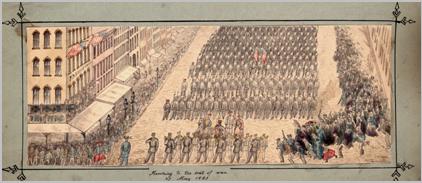| The "German Rifles" |
| Pictured below are water color sketches by Private Henry Berckhoff of the 8th New York "German Rifles" May 27,1861 to May 23,1863. The Eighth New York participated in several significant battles, including the Second Battle of Bull Run (Second Manassas). There were 524,509 total known deaths in the Civil War: 359,528 Union and 164,981 Confederate. Henry Berckhoff was a twenty year old young man when he enlisted as a Union soldier during the war. He became a private in the Eighth New York Volunteer Infantry, Company B, which was also known as the First German Rifles and was composed of approximately 1,000 German immigrants. Berckhoff sketched pictures he later colored and bound together. When The Eighth New York's term expired in April 1863, Berckhoff then served with Company A of the Fifth New York Veteran Volunteer Infantry until the end of the war. He continued to serve in the military until his retirement in February 1894. These drawings represent the early years of Berckhoff's military career. Under the command of General Louis Blenker, the Eighth New York Volunteers marched off to war in the spring of 1861 to the cheers of German-Americans and other New Yorkers lining Broadway. They were unique among volunteer regiments in that they had an artillery unit plus a medical detachment with ambulances. The soldiers had two uniforms: a regular blue uniform and a distinctive gray dress uniform. Their park-like Washington, D.C. camp, with the soldiers' tents in orderly rows separated by tree lined lanes between each division's regiment, was actually a tourist attraction. 1861 newspaper article: "Parade of the New York Twentieth German (Turner Rifles) Regiment": This noble regiment, which is composed of German Turners, who are most proverbial in Faderland for their accuracy in bringing down anything at which they point their rifles, had a parade yesterday through the city without arms. They formed opposite Turtle Bay Park in Forty-third street, where they have been quartered since they became embodied, about half past two o'clock, and started about three for the City Hall Park, by the following route: Down Second avenue to Fortieth street, through Third avenue to Twenty-second street, through Twenty-second street to Sixth avenue, on to Twenty-first street, up Twenty-first street to Broadway and down Broadway to the City Hall, where a large concourse of people had assembled to see them. All along the route the Rifles were encouraged in the most flattering manner. More than the usual quorum of the German element was observed along the streets where the soldiers passed with firm tread and martial mein, and soft voices, which once rang musical along the gorgeous Rhine, were heard singing out their appreciation of their countrymen. Broadway, always effervescing cauldron of public excitement, bore an appearance which to a looker on at a distance, would undoubtedly appear gay and fascinating but not to one commingling with the crowd of uniformed and uniformed humanity who kept surging on in great excitement, crushing crinolines in all of citizens and demolishing the corns of fastidious gentlemen with tight patent leathers. On arriving in the park the Rifles broke into column, and wheeled out into Tyron row amid the plaudits of those who witnessed their admirable movements. They then took their departure for Turtle Bay Park via the Third and Second avenues. It is due to the Twentieth regiment of German Rifles to say that they are as staunch and compact a body of men as ever your reporter saw. Their officers are a body of men who may be said to hold no mean position in point of military science; and, on the whole, we are confident that the Stars and Stripes will suffer no unrequited indignity in their presence. (end) |

| The old song "Morgenrot" originally by Friedrich Silcher with lyrics by Wilhelm Hauf was very popular among the German-speaking units in the Civil War. Dieses Lied war oft gesungen bei die Deutsch-sprachigen Kämpfer in dem Amerikianischen Bürgerkrieg. |
| Morgenrot, Morgenrot, Leuchtest mir zum frühen Tod? Bald wird die Trompete blasen, Dann muß ich mein Leben lassen, Ich und mancher Kamerad! Kaum gedacht, kaum gedacht, Wird der Lust ein End gemacht! Gestern noch auf stolzen Rossen, Heute durch die Brust geschossen, Morgen in das kühle Grab! |
| Wearing a sprig of evergreen, considered a symbol of eternal life, on one's cap or coat at a funeral was a German custom. Their fallen comrades were laid to rest with a bouquet of evergreen placed in their hands, and as the procession passed, they dropped their sprigs of evergreens into the graves. That would close the ceremonies. |